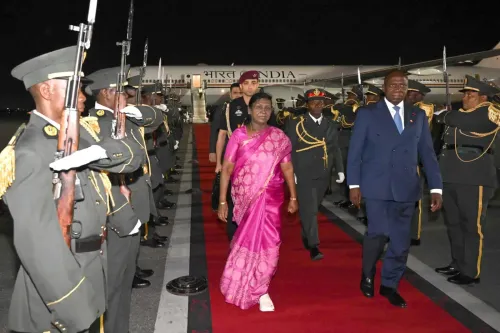What Impact Did Migrant Voters Have on the Voter Turnout Spike in Bihar's Assembly Election?

Synopsis
Key Takeaways
- Voter turnout reached 64.66%, the highest in Bihar's history.
- Migrant workers significantly impacted the electoral process.
- The Chhath Puja festival coincided with increased participation.
- Political narratives surrounding citizenship may have influenced migration.
- Local dynamics and job promises are crucial for future elections.
New Delhi, Nov 7 (NationPress) While women voters in Bihar participated in large numbers during the initial phase of the Bihar Legislative Assembly election 2025, a noteworthy influx of migrant voters is also being recognized as a key factor contributing to an unprecedented voter turnout of 64.66 percent on Thursday.
Many of these workers, primarily employed by businesses, construction sites, or as agricultural laborers in various regions, typically return home for festivals like Chhath Puja.
Chhath is primarily celebrated in Bihar, Jharkhand, Eastern Uttar Pradesh, and Nepal, serving as a thanksgiving festival where devotees honor the Sun God and his sister, Chhathi Maiya, praying for health, prosperity, and family well-being.
This year, the Election Commission’s Special Intensive Revision (SIR) of Bihar’s electoral rolls also encouraged numerous migrants to come back home.
Political narratives surrounding the revision concerning citizenship status reportedly spurred a significant number of laborers to return, coinciding with families reuniting for the festival.
According to Bihar’s caste survey report 2022-23, approximately 2.7 crore individuals reside outside the state. In contrast, the last Census of India conducted in 2011 indicated this figure was over 74.5 lakh.
However, some unverified reports suggest the actual number could range between one and three crore, with opposition parties in Bihar attributing this to the current government's failures to dispute Nitish Kumar’s claims of good governance.
Although there are no concrete figures to determine the exact number of migrants who returned home in October and November for the election process, local estimates suggest the figure is in the “lakhs”.
Notably, the Election Commission reported that 21.53 lakh eligible voters were added to the draft voters’ list, although it is likely not all of them are migrants.
As per the Census 2011 data, the overall count of inter-state migrant workers in India stood at 4.1 crore.
The report titled 'Migration in India', based on the Periodic Labour Force Survey 2020-21, released by the Ministry of Statistics and Programme Implementation, indicated that out of a total of 28.9 percent, approximately 10.8 percent migrated from their home states for employment-related reasons.
While employment prospects may influence these migrants, they do not necessarily vote as a unified entity.
Individual candidate preferences are influenced by factors such as caste, community, performance, and local issues, leading them to support either the ruling National Democratic Alliance, the Opposition Mahagathbandhan, or alternatives like the Jan Suraaj Party and independents.
Ultimately, outcomes will hinge on local dynamics and commitments regarding jobs and development. The Election Commission has declared the 64.66 percent voter turnout in the first phase of the Bihar Assembly elections as the highest ever recorded.
The previous high for voter participation in Bihar Assembly elections was 62.57 percent in 2000, whereas for Lok Sabha elections, it was 64.6 percent in 1998.
With 121 Assembly Constituencies across 18 districts voting on Thursday, totaling over 3.75 crore electors, the remaining 122 seats in 20 districts, comprising about 3.70 crore voters, will hold elections on November 11, with counting scheduled for November 14.









